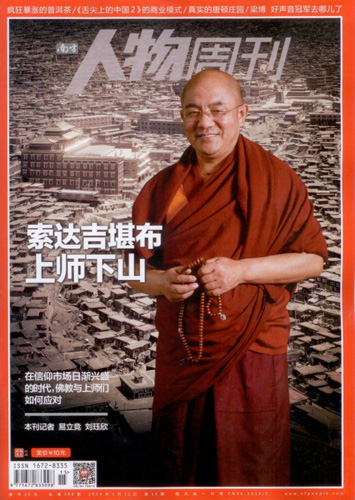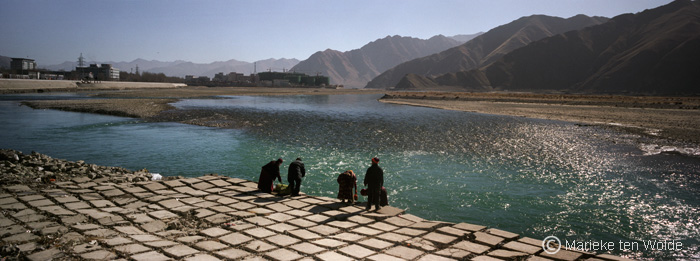Posts Tagged ‘China’
Have you seen him?
‘Have you see him?’, an urgent whisper, ‘Did you see him’? Or rather Him with capital letter: Him, His Holiness the Dalai Lama.
I got this question so often from Tibetans in Tibet: ‘Did I see him, did I meet him, did I go to India’, because I could, if only I would take the effort, and they can’t. The Tibetans asking me would do virtually anything to be able to see him. For me it would be relatively easy, and I never did. They certainly would not understand, in stead they just reassure me that one day I might be lucky. And I have to admit that after I while I did not understand myself either, why did I never go to hear the Dalai Lama speak?
So a little over a week ago that lucky day came, the Dalai Lama was in the Netherlands and I went to his lectures. I tried to take it in, I laughed about the mischief with the hats, wondered about the shoes under the chair, did all the things those other 11,000 people who were there did as well. It was inspiring: a 79-year-old man in red robes sitting on a chair speaking a mix of Tibetan and English for an audience relying on a translator for both languages. Without a show, without special effects, he held us all captive for many hours. Amazing.
I had heard what it would be like and even most of what he taught I had read numerous times already. Still it was special. So I am very glad I could be there.
And I was sad, as I thought of all those people who would so much like to meet him and can’t. Also because it is unlikely this will happen in the foreseeable future; if the Dalai Lama is able to sell out a sports stadium in the Netherlands with 11,000 people, imagine what would happen if he visited Tibet or even Hong Kong. Crowd control would be impossible and I would be very surprised if the authorities would even consider to take that risk. Of course the politicised context around the Dalai lama does not help either.
But there are more lamas, very popular lamas living in Tibet with sometimes hundreds of thousand followers. Yesterday I stumbled upon an article about Khenpo Sodargye Rinpoche a lama from Larung Gar (a very large monastic settlement in the Kham/Tibet) in People Weekly.
Although he also taught in the US, Germany etc, most ‘westerners’ will not have heard of him, but in China he has 1.5 million Weibo followers. Most of the communication is in Chinese but there is a nice English language website and even a Facebook account.
It is lamas like Sodargye Rinpoche that keep Tibetan Buddhism alive inside Tibet and spread it beyond Tibet into China. And it is good to see that there is an interest and appreciation for their work in China, as this article shows clearly. Something the Dalai Lama himself mentioned a few times to the Dutch reporters asking him about the repression of Tibetan Buddhism in Tibet.
Mixed Messages and Photos of the Dalai Lama

.
Two weeks ago there was all of a sudden the happy news that Tibetans could own and show photos of the Dalai Lama (see here), that Tibetans would be allowed to display these publicly and revere the Dalai Lama.
Although this was not confirmed from official sites it was a hopeful sign. But only 2 weeks later Tibetans celebrating the birthday of the Dalai Lama in Tawu (Sichuan) were shot at.
Then 3 days later the news came out that China might be loosening grip on Tibet and maybe even reopen conversations with the Dalai Lama, a change in policy which was welcomed in many publications but then immediately denied by authorities in China.
I am confused by this, and I am even more confused by all the interpretations of these news events in the press. For a few days it felt like the Kremlin watchers from the cold war had turned their interest towards Tibet. Still I am happy with every sliver of good news and any indication of a change.
With regards to photos of the Dalai Lama there seems to be a big divide between the official policy and what has been happening. Even Kumbum monastery, frequented by thousands of tourists each year and generally considered quite tightly monitored, had a photo of the Dalai Lama openly on display. The photo was of a very young Dalai Lama and therefore hardly recognizable for me (I am ashamed to admit I had to ask the monk in charge), but still many people came to show their respect despite the many CCTV cameras pointed at the photo.
I took the above picture in Gandze in 2010. There is not just one picture of the Dalai Lama, and not just a very young Dalai Lama, but the whole temple was covered with them. I also visited this temple in 2001, at that time it was empty without any visitors and the monks told disillusioned stories about the Cultural Revolution when the temple was used as a granary. But in 2010 the temple was very busy with a constant stream of people filling the butter lamps and leaving donations.
Not all had improved the monks had become a lot less talkative, when I tried to ask them about the photos, my questions just made them very nervous, like my camera did. But, although they did not want to admit it, I am sure that the newfound popularity of this temple had one very obvious reason. The cynic in me thought it was a rather risky marketing strategy, the optimist in me saw some change for the better.
Thinking about it a bit more I also start to understand why the authorities in China are so cautious around any statements with regards to allowing these photos. The eagerness of the Tibetans to resume public devotion of the Dalai Lama and other high lama’s, even after all those years since they left, could easily surprise them.
Tibetan Sushi
.
Last week when I delivered a couple of my books to a store in Amsterdam with all sorts of things Tibetan, there was a Tibetan man, tall impressive, long hair in a fashionable bun. He was chatting with the shopkeeper about preparing food, actually preparing the fish from the tank at the shop keepers home into sushi. First jokingly then more seriously as it turned out he was running a sushi restaurant and he noticed the title of my book ‘Freeing the Fish’.
‘Freeing the Fish’ refers to the first story in my book and the practise in Lhasa for Tibetans to buy live fish in market to set them free in the river to save lives and gain merit.
We had a laugh about this coincidence and joked about his business. But the conversation turned more serious when the man who was even addressed as Rinpoche (a reincarnated Lama), explained that he would donate a lot of the money he earned with the restaurant. He indicated how fat the pile of banknotes would be that he would hand to monasteries and charity for blind people in Nepal. I have no idea why he chose to run this particular restaurant, he might have very good and valid reasons, but still there was an apparent sense of guilt. Luckily it seems possible to counterbalance at least some of the bad karma from running a Sushi restaurant by donating to monasteries. The principle of setting off good deeds against bad apparently is very common, at least it sounded very familiar to me.
I have met Tibetans that eat fish, not so many years ago some (relatively) well to do Tibetans quite enjoyed the fish restaurants in the Chinese parts of Lhasa. They only stopped going there after the Dalai Lama had made some statements about eating fish. Some even ventilated their displeasure with the fact they could not eat fish anymore.
Maybe this is when the whole ‘Freeing the Fish’ practise really took on the scale it has now. I found this very interesting video on youtube showing how Tibetan businessmen donate a lot of money for buying the fish and make it into a special day to release the fish. Trucks filled with water and fish drive to the river where the fish is released from boats flying the Chinese flag.
I wonder if running up to Saga Dawa (Buddhist celebrations, remembering the birth of the historical Buddha), which is considered an auspicious time for releasing fish, the fisherman work over time to be able to fulfill the demand. Like eggs at Easter or turkey at Christmas. If the Tibetans are really opposed to fishing, and freeing fish is not just a way to gather good karma during festive days, maybe it would be better to not buy fish.
After deliberating on the freeing the fish practice for a couple of days, I still only know one thing for sure; Freak coincidences do occur in real life.
.

Tibetans releasing fish in the river, Lhasa
Freeing the Fish, the book
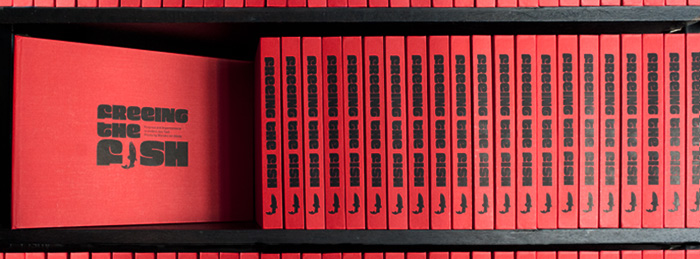
.
The last months I have been very busy with finalising the book about the changing and modernising life in Tibet. Last week I received the result of all the hard work on design, lithography, paper choice etc. It looks really great. And it is so nice to finally be able to hold the book, smell it, go through the pages. I guess I am still in love the tangible paper-based book, although all the online and e-stuff are great as well.
‘Freeing the Fish, Progress and Impermanence in modern-day Tibet’ is a photo book which also contains 20 of my stories that provide you with background information about the life in Tibet. The stories sometimes have a personal touch, are a little more serious than my blogs and are all new!
You can have a preview at my website. The book turned out really well, so I am very pleased to now be able to sell this through my web-shop.
For everyone in the Netherlands: At FotoFestival Naarden I have a large photo series exhibited (the festival runs until 23 June). The photos in the book, especially the spreads are quite big (almost 60 cm wide) but at the festival the panoramic images are almost one and half meter and that is yet something different. It feels like you are submerged in the Tibetan world, for a moment at least…
So if you have the chance, come and see. I will be there on 1 June and 9 June and you can also buy the book at the festival.
For all of you who will not be able to come, below an impression of what it looks like.
Speedy woodblock printing

.
Derge (Dege) has in the past 15 years turned into a largely modern town with a lot of concrete high-rise. Only up the hill a small traditional neighbourhood is left. And there is the Derge Parkhang. The building is the main center for Tibetan woodblock printing, it also has fancy names like the Derge Sutra Printing Temple. though it is not really a temple, people are circling the building in reverence to the woodblocks with the Buddhist scriptures held inside.
After the rather ugly city with the strange mix of modern concrete and Tibetan elements entering the Parkhang is like going centuries back in time. It is dark and cool and the only sound is of inking the woodblocks and some rustling of paper. That is until the first Chinese tour group comes in and the cameras start clicking. But tour groups are always in a hurry and I have time, so they come and go and the quietness returns.
I watch in amazement how quickly the men work, page after page after page by hand. The men work in couples sitting opposite each other; one will put the paper on the woodblock, the other applies the ink, the first one will remove the paper and put it on the pile where the ink can dry. They do this faster than the eyes can see, or my camera can capture in the low light. A modern printing press must be faster and more efficient but here they have centuries of experience and that shows.
.

.
Not only the printing but also putting the strips of paper into the right order, bundling the paper into books, they have the process down to a fine art. Even the (inevitable) continuous flow of tea for the workers is part of the smooth process. There is no bookbinding though, Tibetan books traditionally have loose pages between two wooden boards and wrapped in cloth.
Back outside I realise that the whole experience will hardly translate into photos, moving images and sound will be required to give a feeling of the speed at which the books are printed. So next week when I am at a (modern) printing press for my own book printing I might just try filming.
.

.
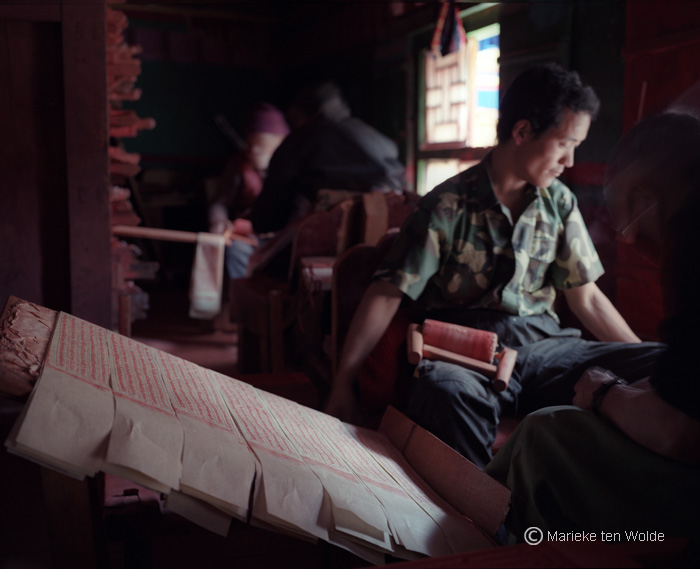
.
Book editing Tibetan style

My blog posts have been a bit intermittent in March because I was very busy with getting the book ‘Freeing the Fish’ ready for print. And that has proven a lot more work then I thought it would be. I used to think that the way Tibetan books were traditionally printed was a bit inefficient and time consuming, I am reconsidering my views on this now; I have not been doing much better.
But one thing is very similar to all book making, endlessly going through texts to edit, re-edit and after that still find another typo to correct. The traditional Tibetan woodblock printing requires careful checking of the woodblocks. Not just when the blocks are just carved, they also get damaged by being used, which might change the meaning of the words. So in the winter, when it is too cold to print as the ink will not dry, the wood blocks are checked. Each page printed, carefully read and mistakes marked in red and then the woodblocks can be corrected or repaired to be used again in the warmer season. Even printing used to have a seasonal aspect to it in the old days.
.
.
I went into this workshop on a freezing cold day in January, it was very quiet in the room with everybody reading. It was very nice, no-one really took much notice of me and I could work undisturbed and quietly on my pictures. The men were a bit surprised by my fumbling with cameras, film and tripod. The shutter release cord was handed down the room in amazement, but apart from that they were just concentrating on the text. The release cord always attracts a bit attention, I once visited a temple where some monks thought it was a device to clean the ears. I guess they had seen all the weird tools the Chinese use for cleaning ears, so I had to stop them when they started to try out my release cord.
In this room it was freezing cold, it would be warmer to sit outside in the sun. I guess drinking liters of hot tea helps a little, they all have multiple flasks, but I would not like to sit still on the cold damp floor hour after hour. Apart from that it seemed a nice enough job and at least they did not have to read the same self written text over and over again, like I did in the last few weeks
.
The month of March
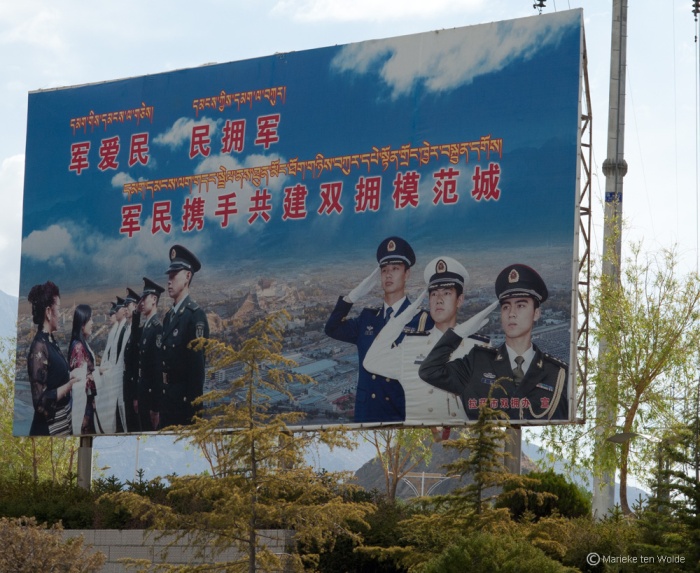
.
For the foreign traveller March in Tibet simply means: no bus, no access, no explanation, no discussion. This year was no different from last year and the year before.
Many Tibetans outside China observe Tibetan Uprising Day each 10th of March, often with large protests against the Chinese oppression in Tibet. Starting this year the Tibetan National Uprising Day will also be observed as Tibetan Martyr’s Day to commemorate the sacrifices made by Tibetans inside and outside Tibet, this was decided during the Second Special General Meeting of the Tibetan People held in September 2012 (in exile).
In 2008 the 49th anniversary of the Lhasa uprising, triggered protests and riots in Lhasa and other parts of Tibet.
The authorities in China responded in 2009 with commemorating “the 50th anniversary of the defeat of the pro-independence uprising in Tibet in 1959 and the emancipation of millions of serfs”. Serfs Emancipation Day has since been celebrated each year on 28 March. The 28th of March is the day that Chinese Communist Party announced the creation of the Tibet Autonomous Region and dissolved the old Tibetan government. Serf emancipation day is celebrated with colourful festivities with song and dance, it looks happy enough, though a little fake, on the news items from the official channels.
But there is a lot of tension around these days, which represent two very different views on Tibet both in the past and now, with increased security measures from the authorities. As a result all Tibetan areas have been closed for foreigners since 2008 during March. Also travel for Tibetans is restricted in that period. Sometimes this period is extended into February and April, to include Losar (Tibetan New Year) and other festive or historical days in the period. I have been caught out in February 2012 when all Tibetan areas already closed for foreigners early February (for a photographer in search of snow it is not easy if February and March are off-limits).
But it is April again, it will start to be a little warmer and with the sun gaining strength the lower grasslands in the valleys will soon start to show a little bit of green. That beautiful first green, so soft and yellowish it is barely there but makes everybody smile.
Because I am not allowed in Tibet during Losar, the Tibetan New Year, for me it always feels the Tibetan New Year starts in the first days of April. I hope this year will be a quiet and happy year.
The photo is a billboard in Lhasa, if there is someone who can translate I would be very gratefull
Let me take your picture!

.

.
Tibetan families albums, you would expect they exist, but I have met many families and stayed in many houses and still I saw very few pictures that were over 5 years old.
Of course there is the occasional picture that the foreign tourist has sent and the many pictures of lama’s, monks, religious objects and monasteries. These are often pinned to a wooden pillar in the house or taped to the wall. I never saw a family album, wedding pictures or anything like that. It seems that photography for the normal Tibetan only started in the digital era, or that they simply do not care much for pictures. Now, very similar to what we see in our part of the world, there are tons of mobile phone pictures and bad snapshots of people in front of something supposedly interesting. And it seems that almost 90% of the time people feel the urge to make the victory sign as soon as the camera is pointed at them.
However I also noticed that the pilgrims visiting Lhasa had their picture taken. In Lhasa there are some photo studios with fancy backdrops of mountains, monasteries, the Potala (the Dalai Lama’s palace), a waterfall or something with a similar attractiveness. Sometimes these studios would even provide a set of traditional clothing. But the most interesting I found the photographers in front of the Yokhang (the main Buddhist temple in the center of Lhasa).
Up till a few years ago many Tibetan pilgrims had their picture taken there, and for a long time this was all analogue. I really liked the creativity of the photographers and I asked them to take a picture of my friend. We first had to choose the frame for the picture, she insisted on the heart shape. It was indeed ‘fast taring a picture – fast developing a piece of film‘ because only 2 hours later we could pickup the result: she received the picture, I the negative neatly folded in a little envelope made of old newspaper.
This experience would suggest there must exist more photos than I have seen. So I remain curious about the family albums Tibetan families might have of their daily life, their celebrations (in Tibet) etc. So if there is anybody that could help me with this, or could point me to some more results (like the one below), please let me know!
Dangerous roads
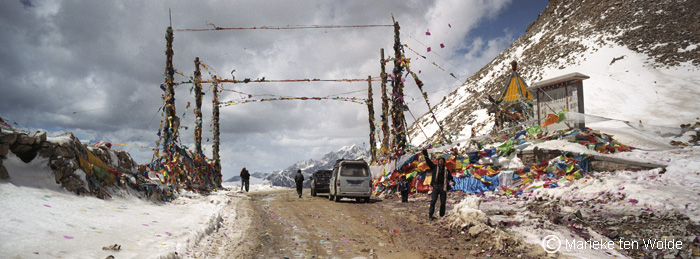
.
Roads in Tibet can be bad and slippery with mudslides or rocks falling down and the slopes very steep. Most of the time the local people seem to be totally at ease with this and the drivers confident and skillful. But when my Tibetan driver got very tense, and I saw Tibetans leaving the bus in front of us preferring to walk, I got a bit nervous.
Late winter the pass between Manigango and Dege was still covered with meters of snow. In the morning the traffic from Dege to Manigango was let through, from 14.00 onwards the traffic in the opposite direction was allowed to enter the pass. It was clear why: it would be impossible to pass an approaching car. A few unlucky cars broke down and it took hours to overtake those.
As we went up my Tibetan driver was suffering from the altitude, a headache and nausea. Apparently the difference between the 3000 meters he was used to and the 5051 meters (according to the sign) at the pass was too much of a difference. Maybe he spent too much time at the low altitude of Chengdu. He kept popping pills. I have no idea what kind of pills, as they came out of a non-descript white paper bag. He offered me some as well, but I was fine just a bit exhilarated from the lack of oxygen the cold and the clean air, but that was not unpleasant and I did not have to drive.
I never really considered the possibility of a Tibetan suffering from altitude sickness and this was worrying because the slope next to the road was pretty much vertical and going down hundreds of meters, the road was narrow and slippery from the mud and sludge so the wheels lost grip all the time. It was often not possible to look over the snow piles moved to the side of the road, which gave a misplaced sense of safety: where the water was seeping through I could see the slope going straight.
At the pass it was very cold and windy. Still most people got out of their cars to throw the colourful little papers with the wind horses (lungta) , which can bought everywhere in large piles for a few Yuan, in the air. Many of the colourful papers were flying around, each little paper representing a prayer that flies with the wind to the skies.
It is part of Tibetan Buddhism, but here it also felt like everybody was relieved to at least have made it to top and the colourful papers looked like a sort of celebration. It was gorgeous at that highest point, mountains all around, the snow, the prayer flags and the sky so close it could almost be touched. I threw my wind horses as well and offered my driver a pile, but he was just cold and miserable huddled in his car seat. It seemed wise to get down as quickly as possible.
We again saw cars and busses that had fallen of the road, hundreds of meters down. I asked my driver what happened with the people, if he knew how many people died here. The answer was as simple as it was disturbing: many accident happen on this road and those people either died immediately or if they were unlucky it would take a while, as it would be impossible at this circumstances to reach them and rescue them. Bodies would be collected in springtime.
On the way back I gladly made a 3-day detour to avoid that pass.
.

